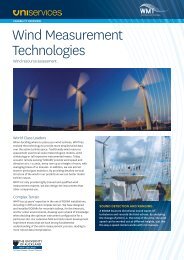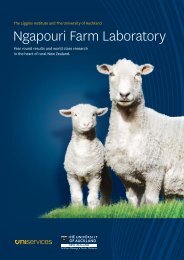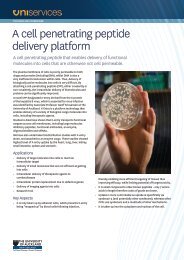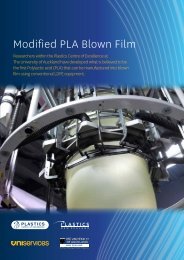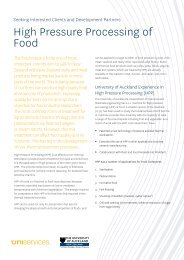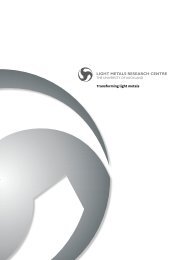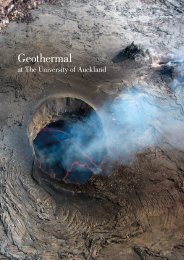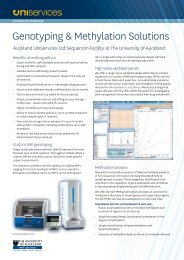The Geothermal Institute brochure - UniServices
The Geothermal Institute brochure - UniServices
The Geothermal Institute brochure - UniServices
You also want an ePaper? Increase the reach of your titles
YUMPU automatically turns print PDFs into web optimized ePapers that Google loves.
<strong>Geothermal</strong> TechnologyInnovations<strong>The</strong> University of Auckland always seeks to bring new and improvedtechnologies and techniques to locating, developing and managinggeothermal energy. Recent innovations from the <strong>Geothermal</strong> <strong>Institute</strong>include:Joint Geophysical ImagingIn the area of geothermal exploration, IESE offers a unique JointGeophysical Imaging (JGI) technology which involves combining data fromseismographs and other geophysical instruments for analysis andinterpretation, and takes advantage of signal polarisation effectsproduced by subsurface fractures. It is designed to significantly lessendevelopment risks, and therefore costs, by locating optimum drillingtargets. For example, in some geothermal fields, the JGI approach hasresulted in doubling new well outputs by finding high permeability zones.<strong>The</strong> JGI method improves resolution of reservoir boundaries, upflow, fault,and fracture zones, and fracture density and orientation. For developers itoffers a way to reduce the risk-against-returns in geothermal exploration.Engineered <strong>Geothermal</strong> Systems Modelling andMonitoringIESE staff have been developing advanced, data based models of thecomplex interactions of hot rocks and fluids, erratic flow pathways, andthe deformation effects of temperature and pressure changes forEngineered <strong>Geothermal</strong> Systems (EGS). EGS, a high-potentialgeothermal technology that has not been realised on an industrialscale, is intended to work by creating turbine-turning steam throughwater contact with hot rock. <strong>The</strong> process requires enhancing flowpathways in such rocks. <strong>The</strong> EGS process generates small seismicevents (“induced” seismicity). By deploying a borehole seismic networkat such project sites, the location of these microearthquakes can bereadily detected and their magnitudes monitored. This valuable seismicdata can be interpreted for accurate well targeting and ensuring thatseismic safety measures are followed. IESE staff been involved inmonitoring 3 EGS projects: Basel, Paralana, and Naknek.Deep Borehole ObservatoriesWith one of its industrial partners, IESE has co-developed a cableless,downhole seismometer and data acquisition array. Since datarecording is within each sonde of the array, data losses due totransmission noise are eliminated. This new tool is especially wellsuited to the recording of the faintest of seismic signals, perhaps thesmallest ever detected in deep boreholes. In more standardapplications, IESE’s microearthquake monitoring networks are beingused to assist in geothermal development and management by trackingthe locations of seismicity that relate to fluid production and injection.as well as a range of visualisation tools to show the simulation results.PYTHON scripting tools have also been developed to assist withcomplex models such as that of the Lihir geothermal system where theexcavation of a gold mine has to be included in the model.Automated Model CalibrationAn important part of current research is geothermal reservoir modelcalibration which involves the choice of suitable parameter values forquantities such as permeability and porosity in the reservoir. For thecalibration of a large model of a whole reservoir where there may bethousands of computational elements or blocks the problem is verydifficult. <strong>The</strong> modellers are using two innovative sophisticatedapproaches to solve this problem.Fluid Rock Interaction<strong>The</strong> <strong>Geothermal</strong> <strong>Institute</strong> modelers are currently investigating severaltopics involving fluid rock interaction. <strong>The</strong> first of these is the modelingsubsidence in geothermal fields. <strong>The</strong>ir method involves using a couplingof the reservoir modeling software TOUGH2 with a rock mechanicssimulator called ABAQUS. Available geotechnical expertise providesinsight into the compressibility properties of geothermal strata for theABAQUS modeling. A second study is looking at the effect of theinjection of cold water into a hot geothermal reservoir.Reinjection of <strong>Geothermal</strong> Fields<strong>The</strong> <strong>Geothermal</strong> <strong>Institute</strong> modelers have recently carried out a review ofexperience worldwide of reinjection in geothermal systems andcomplemented this with a modeling study to test ideas about where it isbest to reinject: either infield close to the production wells or far awayfrom them. <strong>The</strong>ir results show that infield reinjection should not bepreferred for hot systems like Wairakei but is desirable for hot watersystems where pressure support is required.<strong>Geothermal</strong> Modelling: Sophisticated ReservoirSimulator Development<strong>The</strong> <strong>Geothermal</strong> <strong>Institute</strong> modellers in the Department of EngineeringScience have developed software tools for geothermal well-boresimulation, automated well test analysis and tracking of geothermaltracers. In particular, this group is running large complex models ofgeothermal fields in New Zealand and overseas. In order to do this,very fast solvers have been developed as part of the reservoir simulator



